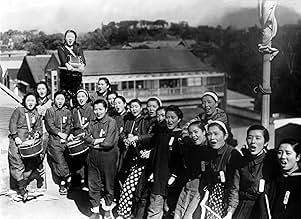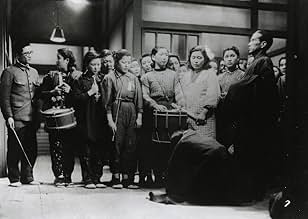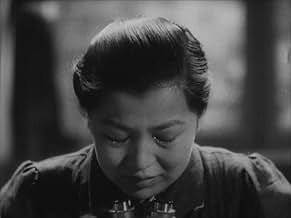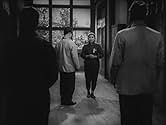AVALIAÇÃO DA IMDb
5,6/10
2,6 mil
SUA AVALIAÇÃO
Adicionar um enredo no seu idiomaWorld War II film about female volunteer workers at an optics plant who do their best to meet production targets.World War II film about female volunteer workers at an optics plant who do their best to meet production targets.World War II film about female volunteer workers at an optics plant who do their best to meet production targets.
Avaliações em destaque
During the World War II, the management of a war industry of optical instruments for weapons requests an effort from the workers to increase the productivity during four months. The target for male workers is an increase of 100% of the production, but the female workers, led by the dedicated Tsuru Watanabe (Yôko Yaguchi), ask the direction to surpass their goal from 50% to 70%. Along the period, the women have to overcome illness and their personal problems to complete their quote.
"Ichiban Utsukushiku" is a war propaganda and tribute to the Japanese female workers in times of war by Akira Kurosawa recommended only for fans of this great director. The plot is boring in many moments, but I liked to see the humanization of the nationalist Japanese workers and this unusual perspective from a people that were sooner defeated in the war. The winners usually write the history from their perspective and this film is a rare testimony from the Japanese point of view. Watanabe is an enlightened character with her dedication and positive leadership. My vote is six.
Title (Brazil): "A Mais Bela" ("The Most Beautiful")
"Ichiban Utsukushiku" is a war propaganda and tribute to the Japanese female workers in times of war by Akira Kurosawa recommended only for fans of this great director. The plot is boring in many moments, but I liked to see the humanization of the nationalist Japanese workers and this unusual perspective from a people that were sooner defeated in the war. The winners usually write the history from their perspective and this film is a rare testimony from the Japanese point of view. Watanabe is an enlightened character with her dedication and positive leadership. My vote is six.
Title (Brazil): "A Mais Bela" ("The Most Beautiful")
Ichiban utsukushiku (1944) 'THE MOST BEAUTIFUL' is Akira Kurosawa's tribute to Japanese Women who supported the war effort (WWII) at the 'Home-Front'. It is analogous to films made in other countries at that time. The nations that participated in the conflict all called upon Women too help in the manufacturing process. Some successfully like Great Britain, Soviet Russia and the U.S.A. Others like China, Fascist Italy or Nazi Germany less so, with Imperial Japan falling in between. Not from lack of effort, but of resources.
Like LETTERS FROM IWO JIMA (2006) the film shows the war from the Japanese perspective. This is a propaganda film. That does not invalidate its message compared with the other participants in the conflict, it is just another point of view, made in wartime. The Women work in a optical factory which could pass for a 'Dickensian Workhouse'. Their work is important and they know it. The pressure of increased productivity with limited resources is clearly shown. It effects them all emotionally, physically and psychologically. The Men of the factory for the most part are unseen drones, except for the managers of the plant. They take a sensitive interest in the well being of their Female staff, without taking advantage of them. The War is largely unseen, but you know it is out there and getting closer all the time. The Director could see the end was coming, even if the Imperial General Staff could not.
The principal cast of Women actors are largely unknowns whose careers were brief before and after this film. They are all convincing in their roles and give believable characterizations. The only 'Star' recognizable too Western audiences would be the great TAKASHI SHIMURA. SHIMURA was a 'jake of all trades' for the TOHO Studios, Japan. His acting range spanned Business Men, Criminals, Detectives, Samurai and Scientists. Films of note, SHICHININ NO SAMURAI (1954) 'The Seven Samurai', GOJIRA (1954) 'Godzilla', CHIKYU BOEIGUN (1957) 'The Mysterians' and YOJIMBO (1961) 'Yojimbo, The Bodyguard'.
Those who have TCM or a well stocked local Library can take advantage of the films of AKIRA KUROSAWA and they should.
Like LETTERS FROM IWO JIMA (2006) the film shows the war from the Japanese perspective. This is a propaganda film. That does not invalidate its message compared with the other participants in the conflict, it is just another point of view, made in wartime. The Women work in a optical factory which could pass for a 'Dickensian Workhouse'. Their work is important and they know it. The pressure of increased productivity with limited resources is clearly shown. It effects them all emotionally, physically and psychologically. The Men of the factory for the most part are unseen drones, except for the managers of the plant. They take a sensitive interest in the well being of their Female staff, without taking advantage of them. The War is largely unseen, but you know it is out there and getting closer all the time. The Director could see the end was coming, even if the Imperial General Staff could not.
The principal cast of Women actors are largely unknowns whose careers were brief before and after this film. They are all convincing in their roles and give believable characterizations. The only 'Star' recognizable too Western audiences would be the great TAKASHI SHIMURA. SHIMURA was a 'jake of all trades' for the TOHO Studios, Japan. His acting range spanned Business Men, Criminals, Detectives, Samurai and Scientists. Films of note, SHICHININ NO SAMURAI (1954) 'The Seven Samurai', GOJIRA (1954) 'Godzilla', CHIKYU BOEIGUN (1957) 'The Mysterians' and YOJIMBO (1961) 'Yojimbo, The Bodyguard'.
Those who have TCM or a well stocked local Library can take advantage of the films of AKIRA KUROSAWA and they should.
Most Beautiful, The (1944)
** (out of 4)
Interesting WW2 era film about a factory in Japan who asks their men to raise production by 100% and then ask the women to do 50%. At first the women are insulted by not being asked to do as much as the men but they soon find out that this raise in production is going to test every bit of their soul both physically and mentally. This early Kurosawa film isn't a good one but it is interesting and does have a few moments where the director does something great. What I found most interesting about the film is how different it is from the WW2 films that were being produced in Hollywood at the time. There's no question that this is a propaganda piece for the Japanese people but it's interesting to see how their moral was attempted at being raised. Most of the American WW2 pictures were "fight, fight, fight" and you can say that about this film but the difference is that the fight is mostly a personal drama with each of the women. Then being ashamed that they can't produce more for their country. Being ashamed that they are sick and can't do their part for a day. Ashamed that their parents might learn they were sick and couldn't do the job. The film does a pretty good job at building up these dramas but sadly none of their stories are strong enough to make the film be a total success. I think most of the blame has to go towards the screenplay that is a bit too over dramatic during certain scenes and there are some major issues with some of the performances. It's obvious Toho didn't give Kurosawa much of a budget but the director shows that he can handle the personal drama quite nicely. The most impressive sequence in the film happens early on when the women are told that production is going to be raised. This somewhat long sequence shows us many of the women talking amongst each other and Kurosawa builds up us thinking they're unhappy about the raise but the way he explains what they're really upset about was quite powerful. The film runs 85-minutes and even at this short pace the film begins to run out of gas and really drag along towards the end. Fans of Kurosawa will probably want to check this out but others will probably hit the stop button early on.
** (out of 4)
Interesting WW2 era film about a factory in Japan who asks their men to raise production by 100% and then ask the women to do 50%. At first the women are insulted by not being asked to do as much as the men but they soon find out that this raise in production is going to test every bit of their soul both physically and mentally. This early Kurosawa film isn't a good one but it is interesting and does have a few moments where the director does something great. What I found most interesting about the film is how different it is from the WW2 films that were being produced in Hollywood at the time. There's no question that this is a propaganda piece for the Japanese people but it's interesting to see how their moral was attempted at being raised. Most of the American WW2 pictures were "fight, fight, fight" and you can say that about this film but the difference is that the fight is mostly a personal drama with each of the women. Then being ashamed that they can't produce more for their country. Being ashamed that they are sick and can't do their part for a day. Ashamed that their parents might learn they were sick and couldn't do the job. The film does a pretty good job at building up these dramas but sadly none of their stories are strong enough to make the film be a total success. I think most of the blame has to go towards the screenplay that is a bit too over dramatic during certain scenes and there are some major issues with some of the performances. It's obvious Toho didn't give Kurosawa much of a budget but the director shows that he can handle the personal drama quite nicely. The most impressive sequence in the film happens early on when the women are told that production is going to be raised. This somewhat long sequence shows us many of the women talking amongst each other and Kurosawa builds up us thinking they're unhappy about the raise but the way he explains what they're really upset about was quite powerful. The film runs 85-minutes and even at this short pace the film begins to run out of gas and really drag along towards the end. Fans of Kurosawa will probably want to check this out but others will probably hit the stop button early on.
Like SANSHIRO SUGATA PART 2, this film was never released in the U.S. for political reasons. There's not any blatantly anti-American content, as in SSP2, but THE MOST BEAUTIFUL, filmed by government request, was a pro-Imperialist propaganda document.
Kurosawa gamely attempts to weave together a story which functions both as propaganda and as a tender coming-of-age story, but isn't entirely successful. This would have been a demanding proposition even for a seasoned pro, let alone a young director like Kurosawa, directing only his second feature.
The story follows a group of young girls working in an armaments factory in the latter days of WWII. The girls must increase production sharply. The girls suffer hardships of all sorts. One, Tao, emerges as the leader of the group. Through the travails of helping her coworkers meet their quotas, Tao learns courage, fortitude and compassion.
If all this sounds a little boring, that's because it is. Kurosawa's visual signatures are seldom seen. At least the performances are good, especially Yoko Yaguchi as Tao. Takashi Shimura has a thankless, do-nothing role as the foreman of the factory.
Kurosawa gamely attempts to weave together a story which functions both as propaganda and as a tender coming-of-age story, but isn't entirely successful. This would have been a demanding proposition even for a seasoned pro, let alone a young director like Kurosawa, directing only his second feature.
The story follows a group of young girls working in an armaments factory in the latter days of WWII. The girls must increase production sharply. The girls suffer hardships of all sorts. One, Tao, emerges as the leader of the group. Through the travails of helping her coworkers meet their quotas, Tao learns courage, fortitude and compassion.
If all this sounds a little boring, that's because it is. Kurosawa's visual signatures are seldom seen. At least the performances are good, especially Yoko Yaguchi as Tao. Takashi Shimura has a thankless, do-nothing role as the foreman of the factory.
Propaganda films are usually of interest to me because of the situation and time period they were made in and their point of view not because of plot or sublime character development. Rarely do the characterizations, I currently cannot think of one, go beyond one or two dimensions. This is because the point of the propaganda film regardless of origin is to rally the troops and align their sense of duty. This movie is no different in that regard. But there are several key differences from the typical propaganda film that makes this film more interesting. The most interesting approach was the documentary approach Kurosawa took. Though he used actresses he did all he could to remove the artificiality of their craft to create a realistic portrait of the young girls at that time who were working in military construction. I felt this movie was effective in that regard. The tempered acting to those that are used to the Noh influenced acting of his later films. Another surprise is that this is one of two films of Kurosawa where the protagonist is a woman. The other one is No Regrets For Our Youth (1946) with Setsuko Hara.
The least interesting aspect of the film is the story. It is about a group of young women in an optical instrument factory that have to push up production to fill the need for the optical lens. While the men were asked to increase their production a hundred percent, the women were asked to do 50 percent. This insulted the women and they asked that they do a more respectable number like 66 percent (would a higher number have been insulting to the men?). The hardships created by this are numerable as the women face sickness, injury, mental breakdown and general crabbiness.
The movie is too episodic and heavy on the "team spirit" motif (not that Kurosawa had much of a choice), but it eventually settles on the titular protagonist in Tsuru Watanabe (Yoko Yaguchi) who embodies the spirit (kokoro) of an ideal worker. Her mother is dying, but her father and her mother want her to stay in the factory working so that Japan will not lose face. What is subversive is that she is a stubborn individualist. When she loses track of lens that she did not finish correcting, she goes through the monument task of finding it, and regardless of the pain it causes her, the lack of sleep and her supervisors telling her she does not need to do it – she does it anyways.
I do not agree with Donald Richie in his The Films of Akira Kurosawa when he states "Twenty years later it is almost impossible for us to think a lost lens this important." She states that she worries that lost lens might result in the death of Japanese soldiers (and possibly in her mind a battle and ultimately the war). It does not matter if she is correct in this thinking, it only matters that she feels that way. Anyone who has any degree of OCD can relate to this. Once the mind gets fixed with an idea that may haunt them it is easy to understand the monomania which consumes her until she finds her mistake.
One thing that surprised me when hearing it in the film, and the fact that Kurosawa got away with putting into the score (he mentions this in his autobiography), is the insertion of "Semper Fidelis" by John Philip Sousa.
Has anyone seen any other Kurosawa film where he uses as many horizontal wipes? After the picture he married the main actress Yoko Yaguchi. It was love at first sight. Kurosawa stated "She was a terribly stubborn and uncompromising person, and since I am very much the same, we often clashed head on." I do wonder how well they got along over the years though.
I think this film can satisfy not only Akira Kurosawa fans but fans of social realist cinema and of course those looking for propaganda films of WWII. If someone is just getting into Japanese cinema this probably could be passed on for quite a long awhile. But for completists (those reading this) they will want to see this. But then again completists want to see everything.
The least interesting aspect of the film is the story. It is about a group of young women in an optical instrument factory that have to push up production to fill the need for the optical lens. While the men were asked to increase their production a hundred percent, the women were asked to do 50 percent. This insulted the women and they asked that they do a more respectable number like 66 percent (would a higher number have been insulting to the men?). The hardships created by this are numerable as the women face sickness, injury, mental breakdown and general crabbiness.
The movie is too episodic and heavy on the "team spirit" motif (not that Kurosawa had much of a choice), but it eventually settles on the titular protagonist in Tsuru Watanabe (Yoko Yaguchi) who embodies the spirit (kokoro) of an ideal worker. Her mother is dying, but her father and her mother want her to stay in the factory working so that Japan will not lose face. What is subversive is that she is a stubborn individualist. When she loses track of lens that she did not finish correcting, she goes through the monument task of finding it, and regardless of the pain it causes her, the lack of sleep and her supervisors telling her she does not need to do it – she does it anyways.
I do not agree with Donald Richie in his The Films of Akira Kurosawa when he states "Twenty years later it is almost impossible for us to think a lost lens this important." She states that she worries that lost lens might result in the death of Japanese soldiers (and possibly in her mind a battle and ultimately the war). It does not matter if she is correct in this thinking, it only matters that she feels that way. Anyone who has any degree of OCD can relate to this. Once the mind gets fixed with an idea that may haunt them it is easy to understand the monomania which consumes her until she finds her mistake.
One thing that surprised me when hearing it in the film, and the fact that Kurosawa got away with putting into the score (he mentions this in his autobiography), is the insertion of "Semper Fidelis" by John Philip Sousa.
Has anyone seen any other Kurosawa film where he uses as many horizontal wipes? After the picture he married the main actress Yoko Yaguchi. It was love at first sight. Kurosawa stated "She was a terribly stubborn and uncompromising person, and since I am very much the same, we often clashed head on." I do wonder how well they got along over the years though.
I think this film can satisfy not only Akira Kurosawa fans but fans of social realist cinema and of course those looking for propaganda films of WWII. If someone is just getting into Japanese cinema this probably could be passed on for quite a long awhile. But for completists (those reading this) they will want to see this. But then again completists want to see everything.
Você sabia?
- CuriosidadesIn order to save film during wartime, the Japanese government ordered films to be released to have no opening titles and thus giving no credit to most of the actors or workers on each film. This included "The Most Beautiful" (1944).
- ConexõesReferenced in Kurosawa: The Last Emperor (1999)
Principais escolhas
Faça login para avaliar e ver a lista de recomendações personalizadas
- How long is The Most Beautiful?Fornecido pela Alexa
Detalhes
- Tempo de duração1 hora 25 minutos
- Cor
- Mixagem de som
- Proporção
- 1.37 : 1
Contribua para esta página
Sugerir uma alteração ou adicionar conteúdo ausente





























